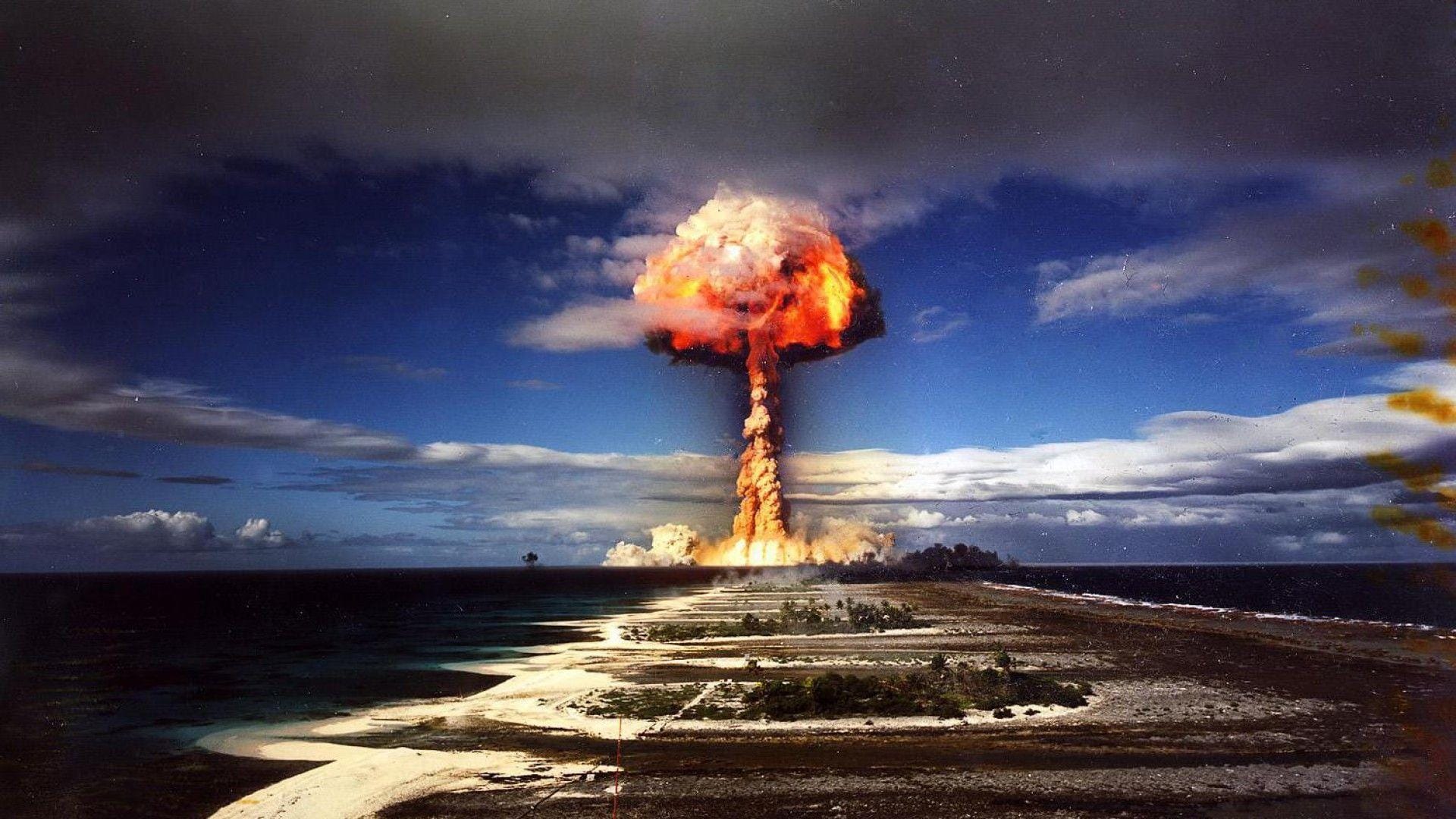Last week, reports appeared that Nobuo Kishi allegedly wrote a tweet condemning the actions of the Ukrainian Armed Forces, in which he compared the Ukrainian military’s shelling of the Zaporozhye nuclear power plant with the American bombing of Hiroshima. We checked whether a Japanese politician made such a statement.
On August 12, 2022, posts with the following content appeared on social networks and Telegram channels: “The new adviser to the Prime Minister of Japan on national security and nuclear disarmament, Nobuo Kishi (former Minister of Defense and brother of the murdered Shinzo Abe), compared the shelling of the Zaporozhye nuclear power plant by the Ukrainian military with the American bombing of Hiroshima and Nagasaki (Kishi’s alleged tweet did not say anything about Nagasaki. — Editor's note). The official called on Kyiv to stop and not bomb the Zaporozhye nuclear power plant in order to prevent a new nuclear disaster. But, apparently, Japan’s friendship with Zelensky is higher, since Kishi deleted the post half an hour later. But the Internet remembers everything.”
Attached to these posts is a picture purporting to be a screenshot of a tweet from August 11, which shows text in Japanese and its automatic translation into English. The phrase goes like this: “The world is on the verge of a nuclear disaster! Ukrainian missiles should not explode over the Zaporozhye nuclear power plant. Don't repeat America's crimes! Today may be the last day of humanity...” In addition, Kishi allegedly attached a collage of two images: on the left is a photo of the Zaporozhye Nuclear Power Plant, on the right is a black and white photo with the inscription “Hiroshima after the explosion of the atomic bomb,” and in the middle is a red arrow pointing from left to right.
Publications about the tweet were posted by large public pages on VKontakte, including "General Staff Portfolio" (176,000 subscribers), "Turned by War" (188,000) and “I am for Putin / VOZ” (40,000), as well as Telegram channels: "Military Observer" (214,000), Rogandar News (157,000), "Ukraine.ru" (114,000), "Olgerd Semyonov | Z" (21,000), etc. Kisi’s words were talked about in the program "News" on the Russia 1 channel, as well as a designer and blogger Artemy Lebedev in a video on his YouTube channel. August 16 on the official Twitter account of the Russian Embassy in the UK wrote about a deleted tweet from a Japanese politician, and then deleted and your tweet.
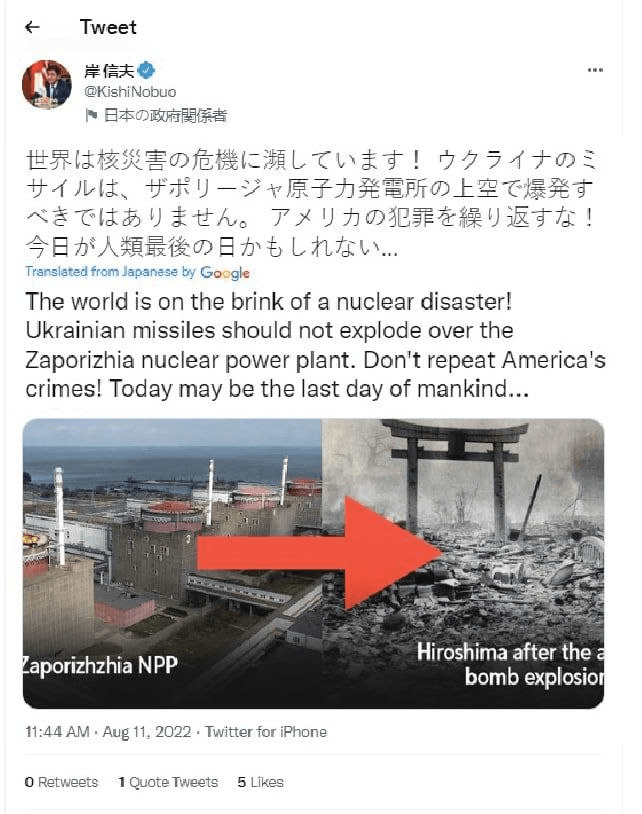
Let's start with the fact that Nobuo Kishi himself called the screenshot a fake. “The tweet distributed by the Russian Embassy in the UK did not originally exist. This is fake. It appears that some users are actively spreading this false rumor." wrote Japanese official on Twitter. Later advisor commented already deleted post from the Russian embassy, asking to correct the tweet with the fake screenshot.
We searched publications on social networks and Telegram and found that the earliest post dedicated to Kisi’s tweet appeared August 12 at 18:11 Moscow time in the Telegram channel “Ponomar” (176,000 subscribers). According to the recording, a subscriber sent the following text to the author of the channel: “I am a Japanese specialist, and because of my work I follow politicians. The Prime Minister's new adviser on national security and nuclear disarmament, Nobuo Kishi (former Minister of Defense and brother of the murdered Abe), apparently became seriously concerned about a new nuclear war. Called on Ukraine to stop and not bomb the Zaporozhye nuclear power plant. Which confused me, to be honest. But, apparently, Japan’s friendship with Zelensky is higher, since he deleted the post. The tweet lasted half an hour. But the Internet remembers everything, I’ve attached a link and a screenshot. https://twitter.com/KishiNobuo/status/1558050777578770433"

Kisi's tweet was allegedly posted on the morning of August 11 and deleted approximately 30 minutes later. Moreover, the first mention of it appeared only the next day in the evening on the RuNet, and all the screenshots that we managed to find on the Internet are absolutely identical - in other words, they are all copies of the same image. Note that Kisi's Twitter has more than 254,000 followers, and his posts from June through August typically received thousands of likes, hundreds of retweets, and dozens of comments. However, as you can see in the screenshot, the tweet about ZNPP allegedly received only five likes and zero retweets—very low numbers for an account with so many followers, even considering that the tweet was allegedly only live for half an hour. It is unlikely that such a resonant post from a high-ranking Japanese official would have gone unnoticed by the public and that no Japanese or foreign media would have written about it.
Your investigation carried out Reuters agency. According to our Western colleagues, they were unable to find any evidence of the existence of Kisi’s tweet about the Zaporozhye Nuclear Power Plant, nor evidence that other users answered for such a post. We will add that not a single Internet user has archived the link sent by a subscriber to the Telegram channel “Sexton”, nor in Internet Archive, neither in Archive.today, so it is not possible to verify whether this link was leading to any tweet. We could not find any mention of this link outside the Russian-language segment of the Internet or on resources not affiliated with government agencies of the Russian Federation.
In addition, we discovered tweets, in which Japanese-speaking users doubtedthat such a text could even be written by a native Japanese speaker. The editors of “Verified” turned to a Japanese scholar for comment Vasily Shchepkin, Associate Professor of the Department of Oriental and African Studies at the Higher School of Economics in St. Petersburg. According to him, in the tweet from the screenshot, each individual sentence is formally grammatically correct, but the last sentence, unlike the previous ones, does not sound like a warning: “This looks like a translation from a foreign language, and it is very likely that it is from Russian - the Russian phrase “Today may be the last day of humanity” is easy to read.” Google Translate translates it exactly as in the tweet, although a Japanese would use the verb “to become”: なる.”
In addition to analyzing the text component of the tweet, we also analyzed the picture itself. Firstly, the low quality of the image immediately catches your eye. It is unclear why the user who took the screenshot did not send it in high resolution. Secondly, the image shows signs of editing. For example, most of the right twitter feed line is missing, which is especially noticeable when changing the contrast of the image. Thirdly, when you zoom in and examine the details, you will notice that all the rounded corners of the image attached to the tweet are noticeably distorted. Below is a comparison of the picture in question with our screenshot of another Kisi tweet.
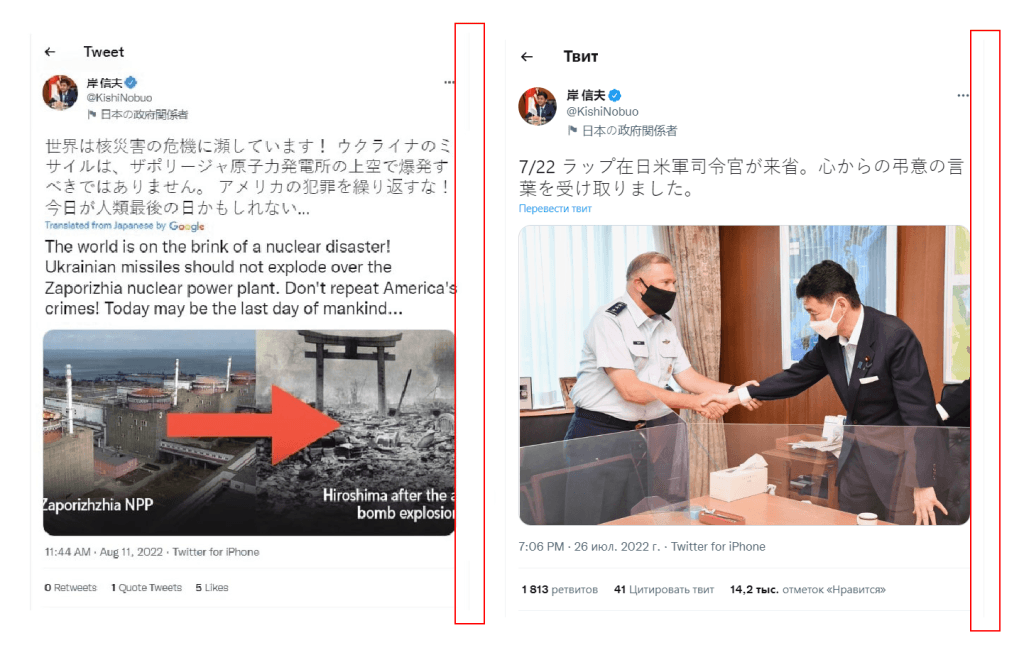
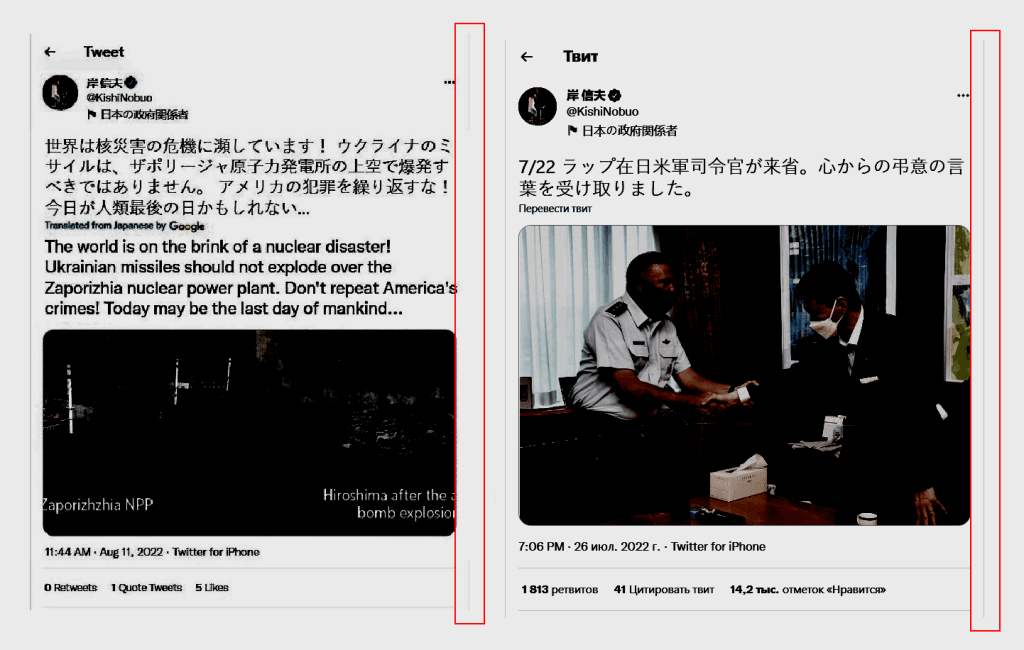
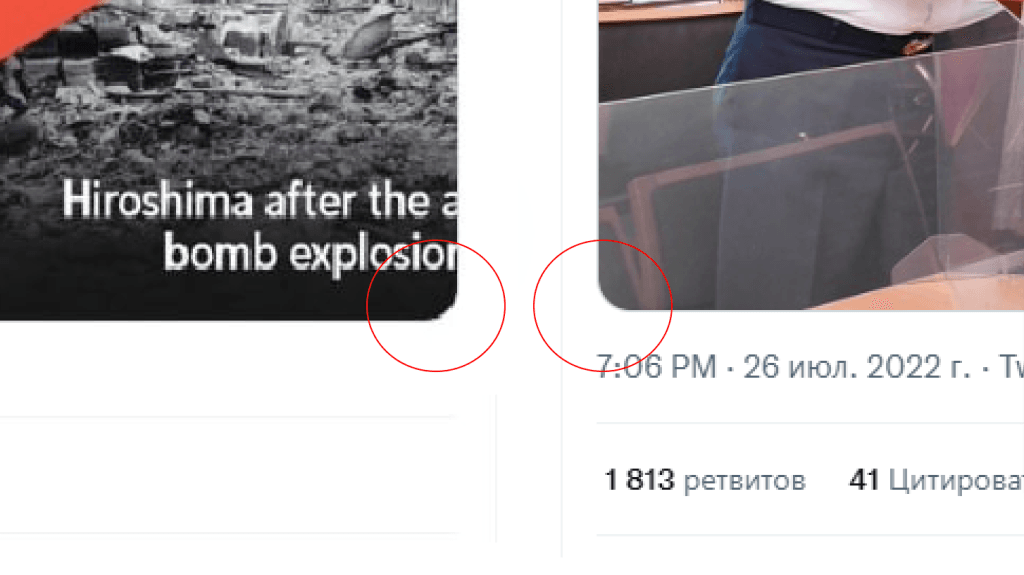
It is likely that someone could replace all the text and numeric data of any of Kisi’s tweets through the code of the Twitter page, and then simply added a picture using a graphics editor, but did it carelessly, which is why the screenshot was not posted in high quality. This is easy to do: you just need to find the necessary elements in the code and rewrite them. Below are two screenshots: the first is Kisi's original tweet, and the second is our version, which took a few minutes to create.
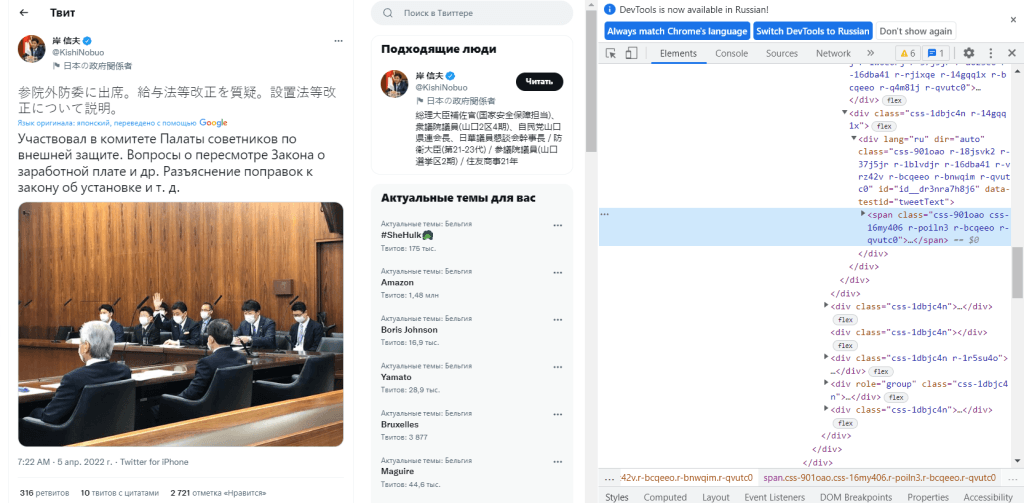
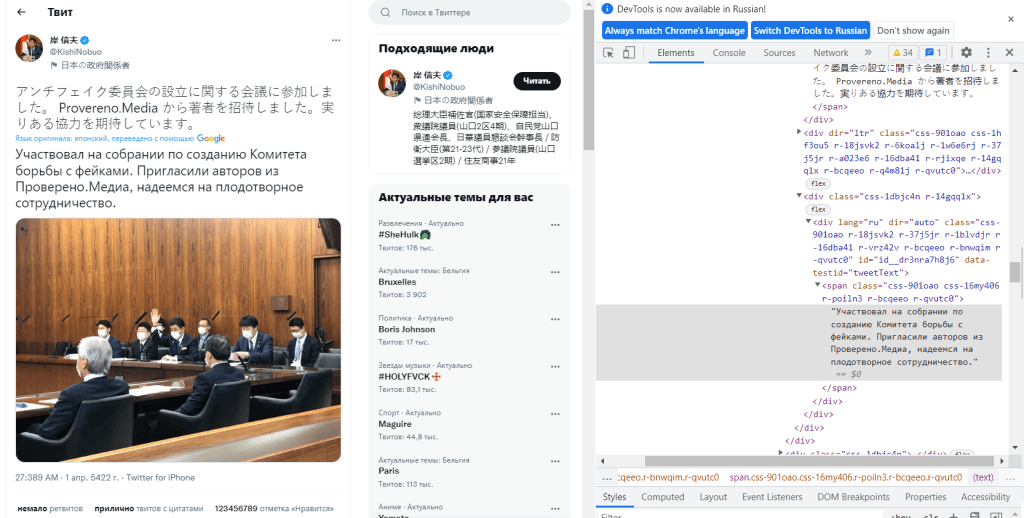
According to the purported screenshot of Kishi's tweet, the former Japanese defense minister attached a photo of the aftermath of the nuclear attack on Hiroshima as an illustration. However, in reality the photograph on the right does not depict Hiroshima, but Nagasaki. In the picture Yosuke Yamahata you can see the famous torii - a Shinto gate that survived the explosion of a nuclear bomb. It is extremely unlikely that a high-ranking Japanese official would confuse the cities destroyed by two nuclear bombs. It is noteworthy that if you make a request on Google in Russian using the words “Hiroshima after the explosion,” then one of the first images in the search results will be will Just this photo from Nagasaki. Apparently this happened due to an error in article on the Radio Liberty website*, published in 2020 on the 75th anniversary of the bombing of the city.
We also managed to find the original photo of the Zaporozhye nuclear power plant, shown on the left. This drone shot demonstrated in the story of Channel One on August 11 (in the video at the 1:36 mark), on the channel’s website this material published under the heading “Zaporozhye Nuclear Power Plant is again under massive fire from Ukrainian security forces.” It is very doubtful that the Japanese official decided to take for his tweet a frame from a Russian TV channel story about the Zaporozhye Nuclear Power Plant, which attracted the attention of all world press, including Japanese.
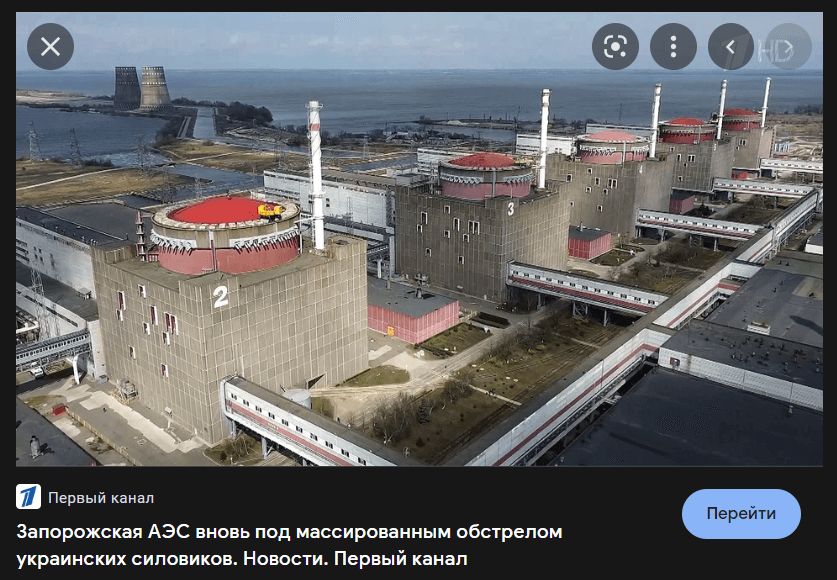
Thus, we can confirm with a high degree of certainty that the screenshot of Nobuo Kishi's tweet is a fake.
*Radio Liberty introduced to the list of foreign media performing the functions of a foreign agent.
Cover photo: Wallpaper Access
Fake
- Is it true that cockroaches can survive a nuclear explosion?
- Is it true that a new species of animal appeared in Chernobyl?
- Is it true that in Soviet times a working nuclear reactor was demonstrated at VDNKh?
- Fake news about what is happening in Ukraine. Part 3
If you find a spelling or grammatical error, please let us know by highlighting the error text and clicking Ctrl+Enter.


